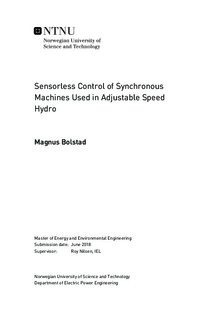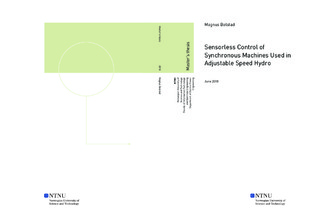| dc.description.abstract | For some high power applications, as for instance in adjustable speed hydro, ASH, synchronous machines are used for power generation. In this master`s thesis, flux models and sensorless control methods for a synchronous generator with damper windings, developed in the specialisation project autumn 2017, has been carefully analysed. A drive is classified as sensorless when no sensors are used for measuring the position or speed, but the position and speed are rather estimated based on the measured voltage and current supplied to the electric machine. Higher reliability, higher robustness, and a reduced size and cost are motivating factors for running electric machines sensorless. The main focus has been on sensorless control at low speed operation, and on parameter sensitivity of the flux models.
Steady state analysis of the current model and the voltage model, which are used to estimate the stator flux linkage, were performed by analytic expressions in Matlab, while the dynamic analysis and the analysis of the sensorless operation were performed by simulations in Simulink. Estimated stator flux linkage and estimated rotor position was used as input to the control system. It was illustrated that the voltage model is sensitive to the estimated stator resistance during low speed operation, and that the sensitivity increases with the generated torque. During steady state operation, only the magnitude of the estimated stator flux linkage was affected by the erroneously estimated resistance, while the angle of the estimated stator flux linkage was unaffected due to the unity power factor control. During dynamics, an erroneous estimation of the stator resistance made the flux linkage estimate drift, resulting in oscillating errors in both the estimated stator flux linkage amplitude and in the estimated stator flux linkage angle. The concept of stator flux linkage drifting, the consequences of it and methods to compensate for it, have been thoroughly explained and illustrated. It has been illustrated how the voltage model is less sensitive to the stator resistance at higher frequencies, and that the speed at the instant when the drifting occurs determines how much the flux linkage will drift. Once the flux linkage has drifted, the offset established is not reduced by increasing the speed, and hence there is a need for drift compensating techniques. Sensorless control without drift compensation did not yield satisfying control, and instability occurred frequently. Changes in torque reference, changes in stator resistance and driving through zero speed are typical scenarios that trigger drifting. It was found that the current model is more sensitive to the q axis inductance while generating a high torque, while the sensitivity to the d axis inductance was highest at lower torques. Steady state analysis revealed that the current model is not completely independent of the speed, as field weakening affects the sensitivity of the model.
When using drift compensation, the machine was able to operate sensorless at low speeds, and to drive through zero speed. The generated torque followed its reference less accurately at low speeds, especially when driving slowly through zero speed while generating a high torque. Providing a torque at standstill for a longer time was not successfully achieved. Finally, attempts were made to improve the sensorless control by combining the flux models in different ways, to obtain a less parameter sensitive closed loop observer.
It was concluded that the closed loop observer eliminates the need for an external drift correction method. By further modifications, better flux estimates were obtained for low speeds, both during the first step in torque reference and through zero speed, assuming that the inductances are known with high accuracy. | |

